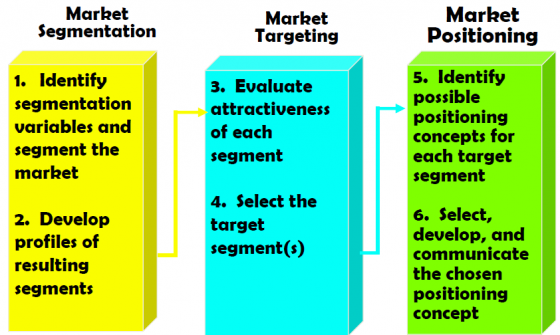Executive Summary
Businesses do not exist in isolation but have to be established in a market environment. At first, the industry sector in which the company operates has to be analysed and described. Market size, market growth, prices, costs and returns are important attributes of a market environment. In addition, overall societal trends as well as market-specific trends have to be identified and analysed. To narrow down the overall market to market segments, which can be tackled by the company, a strategising approach is recommended, consisting of market segmentation, targeting and positioning. Customer segmentation is the process of dividing the market into smaller groups with respect to factors that influence the demand. After the segmentation of the market, a company can identify the customer groups it wants to target. In the end, the company has to position itself vis-à-vis these target markets. To sum up, in a market analysis it is described what a market environment looks like and how a company can best fit into it.
Introduction
Businesses do not exist in isolation but have to be established in a market environment, in order to be successful. To present the knowledge on the market and industry and derived conclusions for the company, the market analysis section is commonly included in the business plan after the company description (SBA NO YEAR). From the understanding of the broad industry the company is settled in, a refinement has to be conducted to narrow down the company’s target market segments. A lot of companies make the mistake to define their target market too broadly and attempt to tackle whole industries instead of concentrating on the niche that is most promising for their products and services (SBA NO YEAR). Some authors also include the competitor analysis in this section, but we keep this separated (check out Competitor Analysis to learn more). In the end, market analysis is all about gathering accurate and relevant data to draw educated conclusions for the business.
Subscribe here to the new Sanitation and Water Entrepreneurship Pact (SWEP) newsletter. SWEP is a network of organizations joining hands to help entrepreneurs design and develop lasting water and sanitation businesses.
Market Environment
At first, the industry sector in which the company operates has to be analysed and described. Here, it is important to gather a clear understanding on the relevant market. This will lay the ground for analysing customers and competitors in the subsequent steps.
An industry characteristic that is highly relevant for a company is the market size (e.g. overall revenues generated in the sanitation market in a specific country). However, an even more important characteristic might be the market growth (e.g. 10% annual growth in overall revenues for the past five years), as it might be easier for a new company to acquire a share of the market growth than a piece of the already existing market which is occupied by competitors. In addition, it is important to gather information on the general levels of prices, costs and returns in the given market.
The identification of current and future trends in the market is crucial. Here, overall societal trends like more sustainable lifestyles or advancing digitalisation of products might be of relevance as well as specific market trends like decentralisation of sanitation management or resource recovery in sanitation.
Market Segmentation, Targeting and Positioning
Once the market environment is sufficiently understood, a company should find strategies to establish itself in the market. Most of the times markets are too big to be tackled as a whole. Therefore, a strategising approach to narrow down the company’s position in a given market is recommended (KERR NO YEAR).

Strategising process: Segmentation (S), Targeting (T) and Positioning (P). Source: BARRETO-DILLON (NO YEAR)
To tackle the market successfully, a company has to identify its target customers. For this, the potential customers in a given market have to be grouped or segmented. Customer segmentation is the process of dividing the market into smaller groups with respect to factors that influence the demand, such as (SMALLBIZCONNECT NO YEAR):
- Geographic: Region, population density, climate etc.
- Demographic: Gender, age, income, education etc.
- Psychographic: Interests, opinions, attitudes etc.
- Behaviourial: Readiness to buy, user status etc.
After the segmentation of the market, a company can identify the customer groups it wants to target, i.e. conduct customer targeting (SMALLBIZCONNECT NO YEAR). Here, decisions have to be made on which market segments the company shall focus. An evaluation of the different market segments, an analysis of their attractiveness and match with the company’s own strengths (see Company Description) has to be conducted.
Positioning then is the act of designing the company’s offering and image to occupy a distinctive place in the target market’s mind (SMALLBIZCONNECT NO YEAR). This step is arguably already part of the company’s marketing strategy and will be discussed in more detail in Marketing.
How to Write a Market Analysis
Create your Business Plan
A guideline to create the market analysis section of a business plan by U.S. Small Business Administration (SBA).
SBA (n.y): Create your Business Plan. U.S. Small Business Administration (SBA) URL [Accessed: 30.10.2015]Business Analysis
How to Do a Market Analysis and Environmental-Trend Analysis
This presentation provides an introduction into market and environmental analyses.
HOLMS, A. (n.y): How to Do a Market Analysis and Environmental-Trend Analysis. UCSB Writing Program and College of Engineering URL [Accessed: 16.12.2015]Market Research Report for Advanced Products, Inc
This document provides an example market research for the fictitious company Advanced Products, Inc.
STRADER, D. (2008): Market Research Report for Advanced Products, Inc. In: Sample Market Research & Analysis: URL [Accessed: 16.12.2015]Conduct a Market Analysis
This document is a guideline on how to conduct a market analysis, including different methods for data gathering and analysis.
VIRTUAL ADVISOR (2009): Conduct a Market Analysis. Virtual Advisor Inc URL [Accessed: 16.12.2015]http://www.wikihow.com/Write-a-Market-Analysis
A 12 step guide on how to write the market analysis section in your business plan.



